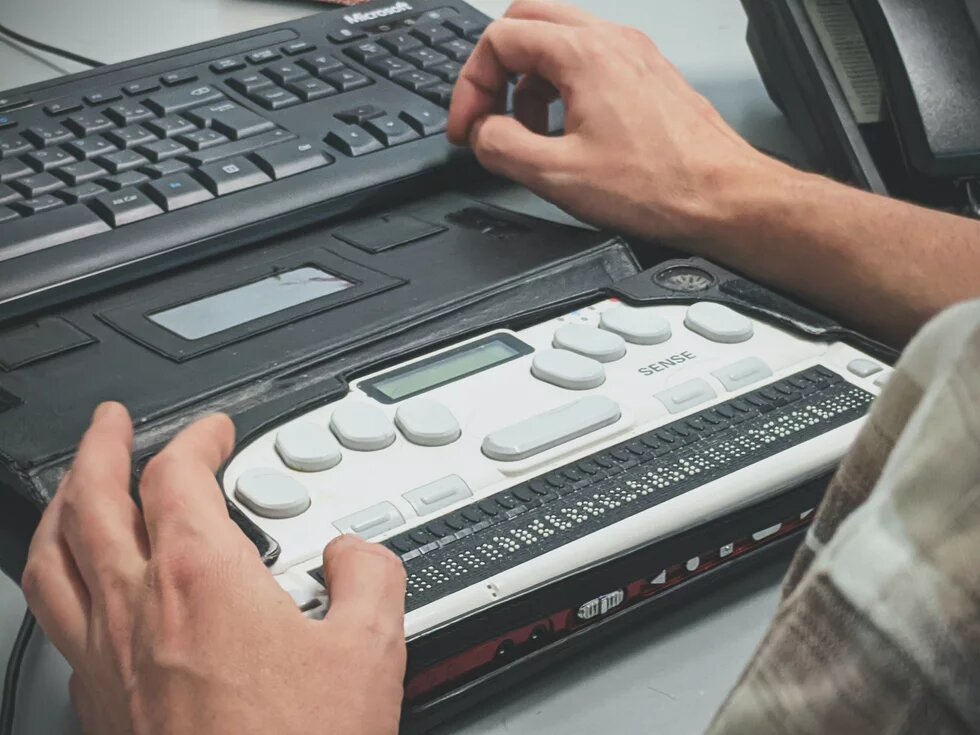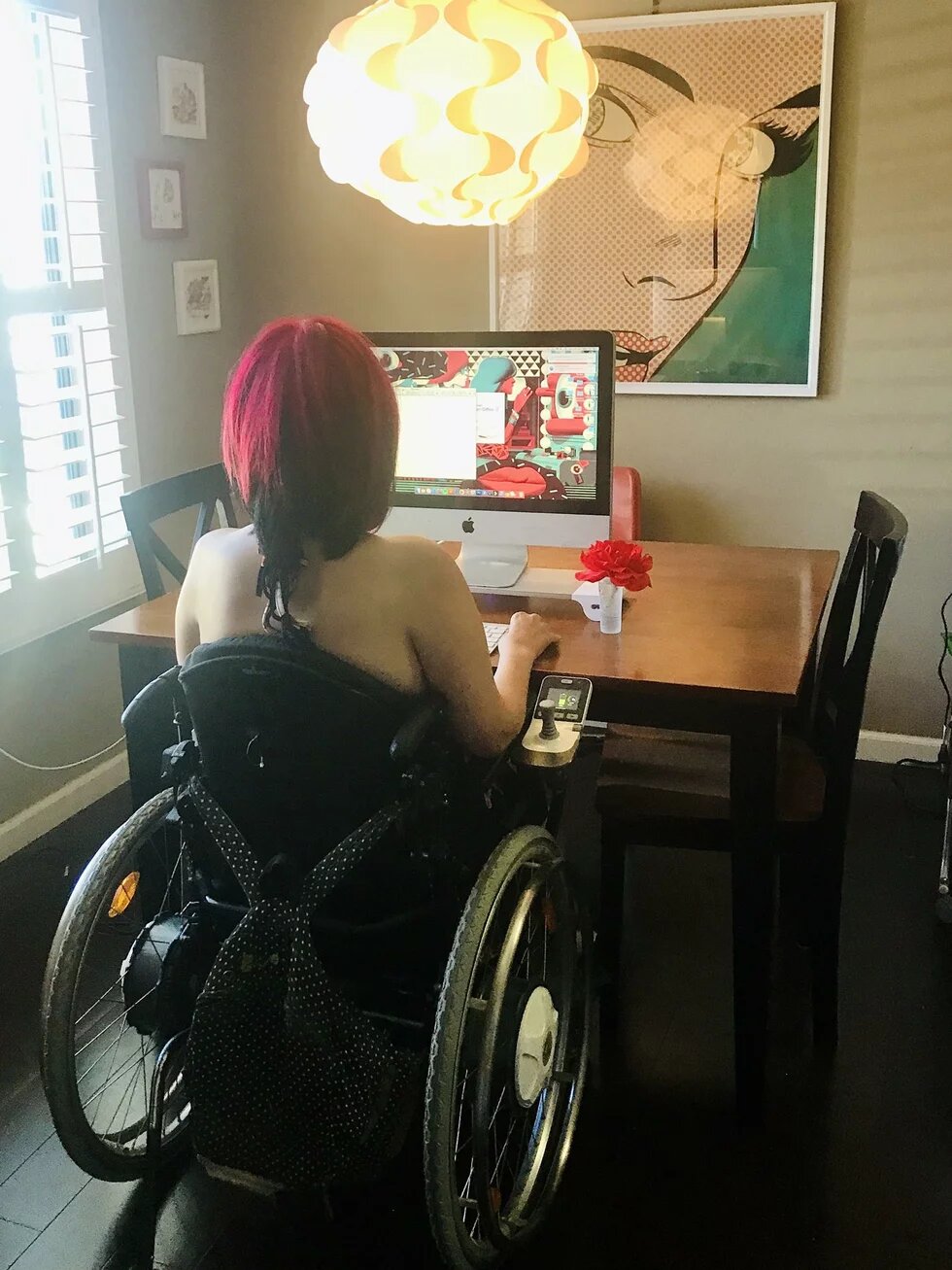
Increased use of digital communication tools during the Covid-19 lockdowns has made working from home acceptable – and even more sociable – for many people with disabilities. But technology still has a long way to go toward inclusion. Four professionals talk about the pros and cons.

“Let’s set up a time to Zoom.” It’s an invitation now familiar – increasingly comfortable – for many people working remotely due to the novel coronavirus. But the impact of such work-from-home tech is more complicated for the quarter of Americans who have disabilities. While working from home has provided a huge boost for the ability of disabled workers to engage more fully, inequities in design and function of much technology continues to create gaps between able-bodied and disabled workers.
Increased use of digital tools like Zoom, Cisco Webex and Microsoft Teams that allow communication beyond the barriers imposed by Covid-19 lockdowns has made working from home acceptable – even made workplace socializing easier – for people with disabilities. Those who use a wheelchair aren’t struggling with transportation to and from work, or having to ask for the help they need to navigate an office. People with mental illnesses have more control over their environment and potential stressors. Speech-to-text software helps deaf and hard-of-hearing individuals better understand co-workers than in face-to-face settings in an office. Artificial intelligence can help someone who is blind detect faces.
For 31-year-old digital storyteller Odochi Ibe, diagnosed with attention deficit-hyperactivity disorder (ADHD), anxiety and depression, the forced adoption of work-from-home practices and technologies that employers have resisted for many years has been a boon. For one thing, It is reducing the incidence of workplace ableism, the otherwise common devaluing of people with disabilities.
“It took a pandemic for people to finally see that everyone in the workplace is valid,” Ibe said over a Zoom call. She lives in Brooklyn and studied journalism at Howard University “Everyone in the workplace should be able to have access to the workplace.”
Ibe said working from home has significantly reduced her ADHD-related stress. Before the pandemic, Ibe would often have to return to her house multiple times after leaving for work in the morning to retrieve a forgotten item. The delays made it a struggle to get to work on time, no matter how early she got up. That’s no longer an issue, and she has recaptured a significant chunk of her days.
While Ibe uses the typical word processing applications, like Pages and Google Docs, it has still been difficult to find open-source software that keeps her on track. The ideal app, she says, would count her work hours and send reminders via browser, phone and Apple Watch. She uses the Forest productivity app, which helps fight distraction by gamifying time not spent scrolling through social media, checking messages or watching videos.
Work-from-home tech eases inclusion
Still, having ease of access to the workplace coupled with a newfound ability to work from home expands the opportunity for some disabled employees to comfortably contribute to workplace discussions and decisions.
“It’s proof to me [that] a lot of jobs can be work-from-home,” said Dana Carpenter, 43, a former researcher for a sales team in hospitality management. She has spinal muscular atrophy (SMA) and had been working from her home in Austin, Texas, for the last seven years until she was laid off in February. More people with disabilities should be able to benefit from such accommodations, even in non-pandemic times, she said.
When Carpenter graduated from college nearly 20 years ago, working from home was “a unicorn out there,” she said. When she worked in the offices of non-profits that focused on accessible and affordable housing, some days it was a challenge just to get to work. During a major storm, for example, she feared for her safety in her electric wheelchair and had to decide every time whether to risk the trek or stay home and forgo her wages that day.
At the office, she skipped lunch because she needed someone to help feed her. Instead, she settled on just a beverage, only asking for help to insert the straw into the cup. Carpenter didn’t use the bathroom until she got home. “All these little things that my manager didn’t understand from the beginning,” Carpenter said.
At home, things are easier. Because she’s unable to lift her arms, she uses a trackball mouse to type and voice-to-text for creative writing and longer emails. Her Amazon Alexa Dot controls the light and fan in her workspace. “The technology has opened the door to more work from home,” Carpenter said.
Kam Redlawsk, a freelance product and graphic designer, writer, illustrator and consultant and disability advocate, felt discriminated against in the office setting. She has GNE myopathy, which causes progressive muscle weakness.
Part of the decision to go freelance was because of the demeaning and demoralizing experience Redlawsk had interviewing for jobs around 2010. One example, which she writes about on her blog, occurred when she was interviewing for a San Francisco-based company designing high-end robotics for kids. Redlawsk, 41, was still in a manual wheelchair at the time. Her prospective boss had raved about her experience when they spoke several times by phone. But during the in-person interview at the office, she struggled to push the wheelchair across the thick carpet and asked him for help. While she admits there’s no way of knowing for sure, she thinks that incident, along with her disability, cost her the potential job.
Now, she doesn’t need to work for anyone but herself. Redlawsk only needs her iPhone, iMac and Cintiq Warcom drawing tablet to do her freelance job. The only accessibility device she uses is a smart plug, which allows her to turn her computer off without the difficulty of having to reach behind her screen and push the power button. An eye tracking device might be necessary in the future, she said, as her disease progresses.
“Technology is so important. People with disabilities are some of the biggest groups that greatly benefit from it,” Redlawsk said. “I see technology as a gateway to an able society, in a way. I’m not disabled when I’m using these types of devices.” Working from home should be a more serious consideration for employers going forward, she said. “It’s really important for companies to start building it into their structural system.”
Robert Kingett, 30, a blind writer in Chicago, Illinois, living with cerebral palsy and an eye disorder called retinopathy of prematurity, said the internet has given a voice not only to him but to many other minorities around him, including Black and trans-sexual Americans. In an interview conducted by email due to his speech disability, Kingett said technology has lowered the barriers for working remotely. “The internet has also given some very beautiful, but dismissed, people the megaphones they deserve,” Kingett said.
He uses Microsoft and Apple-based software, along with the open source NVDA screen reader, because he “loves what both are doing for inclusive design.” As for communication software, Zoom, Kingett said, is the best in terms of providing screen-reader support.
Challenges remain
At the same time, technology has introduced its own set of challenges for disabled people, primarily stemming from the lack of inclusive design, Kingett said.
He said the programs he cannot use with a screen reader are too many to list. One is TikTok, the short-video sharing app. The desktop version, he said, is difficult to use because of the number of empty links and buttons. Another is Discord, a gamer-focused chat app. Even though Discord supports his screen reader, many others with disabilities are left lacking, he said. Blind people who exclusively use a keyboard, without a screen reader or mouse, cannot navigate the app because the tab key is locked in the text box. Others have complained of labeling issues.
Kingett said people without disabilities often prefer to use less-accessible apps because that’s what they’re used to. That’s a problem for him. “A lot of people, and, by extension, employers, are more than willing to just force me to deal with an inaccessible product, because they want to care about their privileged desires over my needs,” Kingett said.
According to Howard A. Rosenblum, CEO of the National Association of the Deaf, their community faces similar struggles. “While most employees were adjusting to how to log onto video-conferencing platforms from home, deaf and hard-of-hearing employees were worried about missing communications during the meetings and had to advocate for access,” Rosenblum wrote.
Ibe sees another downside to working from home: Too much time without structure, as distancing continues with the aid of technology, can be just as detrimental to her mental health. With her ADHD, she could spend hours organizing her bookshelf or taking her dog for an extended walk, only to find the day is ending and nothing was accomplished.
It doesn’t help that working from home coincides with a reckoning with racism in America. The idea of using the newfound time to be productive doesn’t make sense to her. “We are working through a global pandemic and civil rights uprising on top of regular, everyday tragedies. I feel like I don’t have the energy to do any of these things,” Ibe said.
As the coronavirus shows no signs of slowing down in the United States, working from home is here to stay, and Zoom meetings aren’t going away. Google recently announced its employees would not return to global offices until July 2021.
But what remains to be seen is whether companies will allow working from home once the pandemic is over, especially for people with disabilities who particularly benefit from that flexibility – and who benefit their workplaces in turn.

